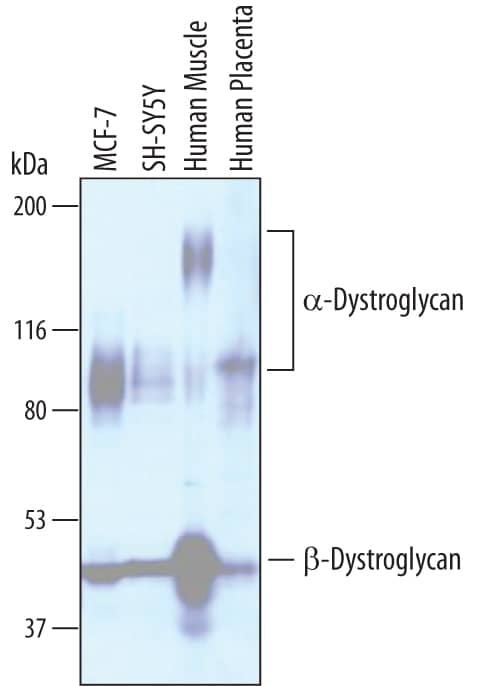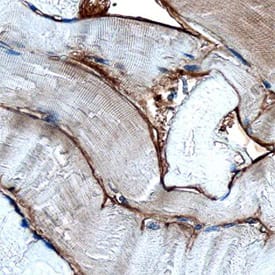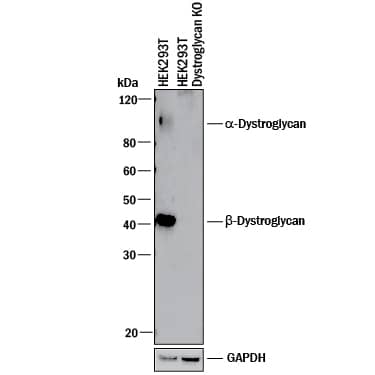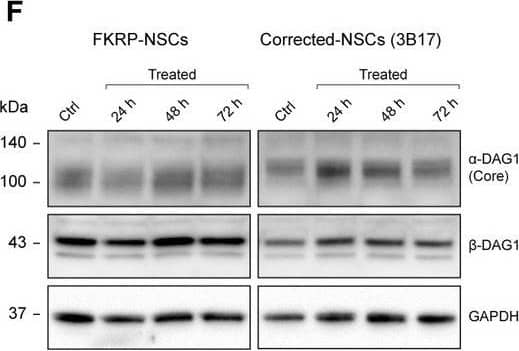Human Dystroglycan Antibody Summary
Gln28-Val749
Accession # Q14118
Applications
Please Note: Optimal dilutions should be determined by each laboratory for each application. General Protocols are available in the Technical Information section on our website.
Scientific Data
 View Larger
View Larger
Detection of Human Dystroglycan by Western Blot. Western blot shows lysates of MCF-7 human breast cancer cell line, SH-SY5Y human neuroblastoma cell line, human muscle tissue, and human placenta tissue. PVDF membrane was probed with 1 µg/mL of Sheep Anti-Human Dystroglycan Antigen Affinity-purified Polyclonal Antibody (Catalog # AF6868) followed by HRP-conjugated Anti-Sheep IgG Secondary Antibody (Catalog # HAF016). Specific bands were detected for a-Dystroglycan at approximately 100-160 kDa (as indicated) and beta -Dystroglycan at approximately 42-44 kDa (as indicated). This experiment was conducted under reducing conditions and using Immunoblot Buffer Group 1.
 View Larger
View Larger
Dystroglycan in Human Skeletal Muscle. Dystroglycan was detected in immersion fixed paraffin-embedded sections of human skeletal muscle using Sheep Anti-Human Dystroglycan Antigen Affinity-purified Polyclonal Antibody (Catalog # AF6868) at 3 µg/mL overnight at 4 °C. Before incubation with the primary antibody, tissue was subjected to heat-induced epitope retrieval using Antigen Retrieval Reagent-Basic (Catalog # CTS013). Tissue was stained using the Anti-Sheep HRP-DAB Cell & Tissue Staining Kit (brown; Catalog # CTS019) and counterstained with hematoxylin (blue). Specific staining was localized to basement membrane. View our protocol for Chromogenic IHC Staining of Paraffin-embedded Tissue Sections.
 View Larger
View Larger
Western Blot Shows Human Dystroglycan Specificity by Using Knockout Cell Line. Western blot shows lysates of HEK293T human embryonic kidney parental cell line and Dystroglycan knockout HEK293T cell line (KO). PVDF membrane was probed with 1 µg/mL of Sheep Anti-Human Dystroglycan Antigen Affinity-purified Polyclonal Antibody (Catalog # AF6868) followed by HRP-conjugated Anti-Sheep IgG Secondary Antibody (Catalog # HAF016). Specific bands were detected for a--Dystroglycan at approximately 110 kDa -and beta -Dystroglycan at approximately 42 kDa (as indicated) in the parental HEK293T cell line, but is not detectable in knockout HEK293T cell line. GAPDH (Catalog # AF5718) is shown as a loading control. This experiment was conducted under reducing conditions and using Immunoblot Buffer Group 1.
 View Larger
View Larger
Detection of Human Dystroglycan by Western Blot Hit compound 4BPPNit validation in the FKRP dystroglycanopathy human iPSC modelsFKRP‐NSCs treated with 4BPPNit showed increased IIH6 reactivity, compared with untreated control cells. Note that the augmented IIH6 reactivity by 4BPPNit is much weaker than that in CRISPR‐corrected‐NSCs. Under the same exposure time, the signal intensity of IIH6 reactivity is saturated in corrected‐NSCs.Representative immunoblots with the IIH6 antibody using FKRP‐ and corrected‐NSCs treated with 4BPPNit for 24, 48, and 72 h, and DMSO only controls.Quantification of alpha ‐dystroglycan glycosylation (IIH6), compared with DMSO only controls.Representative immunoblots of laminin‐binding analysis using FKRP‐ and corrected‐NSCs treated with 4BPPNit and DMSO only controls.Quantification of laminin‐binding activities, compared with DMSO only controls.Representative immunoblots with the AF6868 antibody detecting both alpha ‐dystroglycan core protein and beta ‐dystroglycan in FKRP‐ and corrected‐NSCs treated with 4BPPNit and DMSO only controls.Quantification of alpha ‐dystroglycan core protein and beta ‐dystroglycan expression, compared with DMSO only controls.Data information: Intensities of glycosylation, laminin‐binding activity, or protein expression are normalized to GAPDH protein expression. Note that the left and right panels of the immunoblots in (B) and (D) are not equivalent exposure time. See also Appendix Fig S5. Values indicate mean ± s.d. (n = 3 or 4 biological replicates; one‐way ANOVA; NS, not significant; *P < 0.05; **P < 0.01). Image collected and cropped by CiteAb from the following publication (https://pubmed.ncbi.nlm.nih.gov/31566294), licensed under a CC-BY license. Not internally tested by R&D Systems.
Reconstitution Calculator
Preparation and Storage
- 12 months from date of receipt, -20 to -70 °C as supplied.
- 1 month, 2 to 8 °C under sterile conditions after reconstitution.
- 6 months, -20 to -70 °C under sterile conditions after reconstitution.
Background: Dystroglycan
Dystroglycan, also DAG-1 (Dystrophin-associated glycoprotein 1) is a 180-200 kDa heterodimeric adhesion molecule that links the cell cytoskeleton to the extracellular matrix. It is found on skeletal muscle, cardiac muscle, fibroblasts, smooth muscle and keratinocytes. DAG-1 binds multiple matrix molecules, including laminin-1 and -2, agrin, and perlecan. Intracellularly, the cytoplasmic tail of DAG-1 contributes to a large 400 kDa complex that interacts with the cytoskeleton. The human DAG-1 preprocursor is a type I transmembrane protein 895 amino acids (aa) in length. It contains a 27 aa signal sequence plus an 868 aa proform that undergoes autocatalysis to generate a 626 aa alpha -chain (aa 28-653), and a 242 aa beta -chain. Mature DAG-1 is a heterodimer composed of noncovalently linked alpha ‑ and beta ‑chains. The alpha -chain possesses one potential Ig-like domain (aa 64-162), a mucin-like region (aa 316-485), and a peptidase S72 domain (aa 500-733). It is O‑glycosylated and runs from 100-160 kDa in SDS-PAGE. The beta -chain is N-glycosylated and runs at 42-44 kDa in SDS-Page. It possesses a short 95 aa extracellular region (aa 654-749) plus a 120 aa cytoplasmic domain (aa 776-895). Membrane cleavage of the beta -chain causes dissociation of the heterodimer and generates a 30 kDa truncated form. Over aa 28-749, human DAG-1 shares 93% aa identity with mouse DAG-1.
Product Datasheets
Citations for Human Dystroglycan Antibody
R&D Systems personnel manually curate a database that contains references using R&D Systems products. The data collected includes not only links to publications in PubMed, but also provides information about sample types, species, and experimental conditions.
23
Citations: Showing 1 - 10
Filter your results:
Filter by:
-
POMK regulates dystroglycan function via LARGE1-mediated elongation of matriglycan
Authors: Walimbe AS, Okuma H, Joseph S et al.
eLife
-
Identification of Matriglycan by Dual Exoglycosidase Digestion of alpha -Dystroglycan
Authors: Ishita Chandel, Kevin P. Campbell
Bio Protoc
-
TIM-1 Mediates Dystroglycan-Independent Entry of Lassa Virus
Authors: Rachel B. Brouillette, Elisabeth K. Phillips, Radhika Patel, Wadie Mahauad-Fernandez, Sven Moller-Tank, Kai J. Rogers et al.
Journal of Virology
-
Limb girdle muscular dystrophy type 2I: No correlation between clinical severity, histopathology and glycosylated alpha -dystroglycan levels in patients homozygous for common FKRP mutation
Authors: Maisoon Alhamidi, Vigdis Brox, Eva Stensland, Merete Liset, Sigurd Lindal, Øivind Nilssen
Neuromuscular Disorders
-
Large1 gene transfer in older myd mice with severe muscular dystrophy restores muscle function and greatly improves survival
Authors: Takahiro Yonekawa, Adam J. Rauckhorst, Sara El-Hattab, Marco A. Cuellar, David Venzke, Mary E. Anderson et al.
Science Advances
-
Micro-laminin gene therapy can function as an inhibitor of muscle disease in the dy(W) mouse model of MDC1A
Authors: Packer D, Martin PT.
Mol Ther Methods Clin Dev
-
Clinical, genetic, and pathologic characterization of FKRP Mexican founder mutation c.1387A>G
Authors: Angela J. Lee, Karra A. Jones, Russell J. Butterfield, Mary O. Cox, Chamindra G. Konersman, Carla Grosmann et al.
Neurology Genetics
-
Deep mutational scanning reveals functional constraints and antigenic variability of Lassa virus glycoprotein complex
Authors: Carr, CR;Crawford, KHD;Murphy, M;Galloway, JG;Haddox, HK;Matsen, FA;Andersen, KG;King, NP;Bloom, JD;
bioRxiv : the preprint server for biology
Species: Human
Sample Types: Whole Cells, Transfected Whole Cells
Applications: Flow Cytometry -
CRISPR-Cas9 KO Cell Line Generation and Development of a Cell-Based Potency Assay for rAAV-FKRP Gene Therapy
Authors: Geoffroy, M;Pili, L;Buffa, V;Caroff, M;Bigot, A;Gicquel, E;Rouby, G;Richard, I;Fragnoud, R;
Cells
Species: Human
Sample Types: Cell Lysates
Applications: Western Blot -
Impact of Hypermannosylation on the Structure and Functionality of the ER and the Golgi Complex
Authors: P Franzka, SC Schüler, T Kentache, R Storm, A Bock, I Katona, J Weis, K Buder, C Kaether, CA Hübner
Biomedicines, 2023-01-06;11(1):.
Species: Mouse
Sample Types: Cell Lysate
Applications: Western Blot -
Cancer Malignancy Is Correlated with Upregulation of PCYT2-Mediated Glycerol Phosphate Modification of alpha-Dystroglycan
Authors: F Umezawa, M Natsume, S Fukusada, K Nakajima, F Yamasaki, H Kawashima, CW Kuo, KH Khoo, T Shimura, H Yagi, K Kato
International Journal of Molecular Sciences, 2022-06-15;23(12):.
Species: Human
Sample Types: Cell Lysates
Applications: Western Blot -
Short-term treatment of golden retriever muscular dystrophy (GRMD) dogs with rAAVrh74.MHCK7.GALGT2 induces muscle glycosylation and utrophin expression but has no significant effect on muscle strength
Authors: PT Martin, DA Zygmunt, A Ashbrook, S Hamilton, D Packer, SM Birch, AK Bettis, CJ Balog-Alva, LJ Guo, PP Nghiem, JN Kornegay
PLoS ONE, 2021-03-26;16(3):e0248721.
Species: Canine
Sample Types: Whole Tissue
Applications: IHC -
POMK regulates dystroglycan function via LARGE1-mediated elongation of matriglycan
Authors: Walimbe AS, Okuma H, Joseph S et al.
eLife
-
Ribitol enhances matriglycan of &alpha-dystroglycan in breast cancer cells without affecting cell growth
Authors: PJ Lu, JD Tucker, EK Branch, F Guo, AR Blaeser, QL Lu
Sci Rep, 2020-03-18;10(1):4935.
Species: Human
Sample Types: Cell Lysates
Applications: Western Blot -
biAb Mediated Restoration of the Linkage between Dystroglycan and Laminin-211 as a Therapeutic Approach for alpha-Dystroglycanopathies
Authors: N Gumlaw, LM Sevigny, H Zhao, Z Luo, DS Bangari, E Masterjohn, Y Chen, B McDonald, M Magnay, T Travaline, T Yoshida-Mo, W Fan, D Reczek, JE Stefano, H Qiu, C Beil, C Lange, E Rao, M Lukason, E Barry, WH Brondyk, Y Zhu, SH Cheng
Mol. Ther., 2019-12-06;0(0):.
Species: Human
Sample Types: Cell Culture Supernates
Applications: Western Blot -
Ribitol restores functionally glycosylated ?-dystroglycan and improves muscle function in dystrophic FKRP-mutant mice
Authors: MP Cataldi, P Lu, A Blaeser, QL Lu
Nat Commun, 2018-08-27;9(1):3448.
Species: Mouse
Sample Types: Tissue Homogenates
Applications: Western Blot -
Structural basis of laminin binding to the LARGE glycans on dystroglycan
Nat Chem Biol, 2016-08-15;0(0):.
Species: Rabbit
Sample Types: Protein
Applications: Western Blot -
N-terminal domain on dystroglycan enables LARGE1 to extend matriglycan on alpha -dystroglycan and prevents muscular dystrophy
Authors: Hidehiko Okuma, Jeffrey M Hord, Ishita Chandel, David Venzke, Mary E Anderson, Ameya S Walimbe et al.
eLife
-
A new patient‐derived iPSC model for dystroglycanopathies validates a compound that increases glycosylation of alpha ‐dystroglycan
Authors: Jihee Kim, Beatrice Lana, Silvia Torelli, David Ryan, Francesco Catapano, Pierpaolo Ala et al.
EMBO reports
-
Structure of protein O-mannose kinase reveals a unique active site architecture
Authors: Qinyu Zhu, David Venzke, Ameya S Walimbe, Mary E Anderson, Qiuyu Fu, Lisa N Kinch et al.
eLife
-
Muscular Dystrophy-Dystroglycanopathy in a Family of Labrador Retrievers with a LARGE 1 Mutation
Authors: G. Diane Shelton, Katie M. Minor, Ling T. Guo, Steven G. Friedenberg, Jonah N. Cullen, Jeffrey M. Hord et al.
Neuromuscular Disorders
-
Tandem duplication within the DMD gene in Labrador retrievers with a mild clinical phenotype
Authors: G. Diane Shelton, Katie M. Minor, Natassia M. Vieira, Louis M. Kunkel, Steven G. Friedenberg, Jonah N. Cullen et al.
Neuromuscular Disorders
-
NAD+ enhances ribitol and ribose rescue of alpha -dystroglycan functional glycosylation in human FKRP-mutant myotubes
Authors: Carolina Ortiz-Cordero, Alessandro Magli, Neha R Dhoke, Taylor Kuebler, Sridhar Selvaraj, Nelio AJ Oliveira et al.
eLife
FAQs
No product specific FAQs exist for this product, however you may
View all Antibody FAQsReviews for Human Dystroglycan Antibody
There are currently no reviews for this product. Be the first to review Human Dystroglycan Antibody and earn rewards!
Have you used Human Dystroglycan Antibody?
Submit a review and receive an Amazon gift card.
$25/€18/£15/$25CAN/¥75 Yuan/¥2500 Yen for a review with an image
$10/€7/£6/$10 CAD/¥70 Yuan/¥1110 Yen for a review without an image



